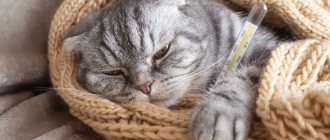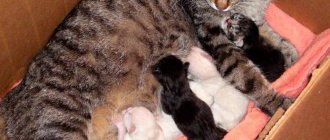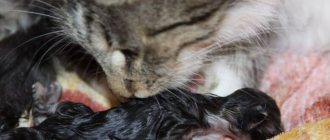9656Administration
Anyone who keeps a cat in the house, sooner or later, as you know, she becomes pregnant. And now, when the long-awaited day of birth is already approaching, the question arises: how long will it take for a cat to give birth if her waters break?
There are symptoms that can help you understand when your cat will give birth.:
- The animal becomes restless and looks for a secluded place
- The cat begins to meow, calling its owner for help
- If you look closely, you can see the first milk being released from the cat's nipples. Veterinarians call it colostrum
- Zetas her water breaks
- Afterwards, contractions begin. The cat lies down and prepares for childbirth
© shutterstock
This is a whole preparatory process for a cat. Therefore, you need to give her due attention, especially if your pet gives birth for the first time. At first the plug will come off. This is a sign that labor has already begun. Then the brown-red water begins to recede. At this time, the woman in labor lies on her side, breathing heavily, and waits for the onset of contractions.
Water breaking and kittens appearing
Cats' water breaks as painlessly as it does for humans.
It is preferable that at this moment the cat is in a pre-prepared nest. Otherwise, she may give birth in a closet, bed, or in another place that is convenient, in the animal’s opinion. The main task of the animal owner is proper preparation for childbirth. To do this you need to prepare:
- clean gauze napkins - 10 pieces;
- old towel - for drying hands;
- disposable diapers or clean old sheets;
- a syringe without a needle, a pipette or a small aspiration bulb;
- scissors;
- antiseptic solution;
- threads
It is recommended to constantly change the prepared diapers during childbirth. This is necessary not only from an aesthetic point of view, but also in order to avoid possible complications in the cat after childbirth. The fact is that blood, placenta and other secretions are an excellent environment for the proliferation of pathogenic microflora. If the rules of asepsis are not followed, the cat may develop postpartum metritis, septic mastitis and other complications.
As soon as the waters break, labor will begin no later than 6 hours later. It is not recommended to move or disturb the animal. A cat may become nervous and, being in a stressful situation, eat all of its kittens. In some cases, complications arise - the kitten gets stuck in the birth canal. You need to help the animal, carefully using clean hands, pulling the baby into the light.
Important! Under no circumstances should you pull the kitten by the limbs or head.
The joints and vertebrae of a newborn are very fragile and one careless movement can cause harm to the baby. You need to try to grab the stuck kitten by the body or folds of skin
They pull the kittens out along the body, taking utmost care, because not only can the kitten be damaged, but the birth canal of the expectant mother can also be severed
You need to try to grab the stuck kitten by the body or folds of skin
They pull the kittens out along the body, taking utmost care, because not only can the kitten be damaged, but the birth canal of the expectant mother can also be severed. The joints and vertebrae of a newborn are very fragile and one careless movement can cause harm to the baby.
You need to try to grab the stuck kitten by the body or folds of skin. They pull the kittens out along the body, taking utmost care, because not only can the kitten be damaged, but the birth canal of the expectant mother can also be severed
The joints and vertebrae of a newborn are very fragile and one careless movement can cause harm to the baby. You need to try to grab the stuck kitten by the body or folds of skin
They pull the kittens out along the body, taking utmost care, because not only can the kitten be damaged, but the birth canal of the expectant mother can also be severed.
If the placenta gets stuck after the kitten comes out, you can independently pull it out with your fingers disinfected in an antiseptic. It also happens that a kitten is born in the amniotic sac. Usually the cat breaks the bubble on its own and licks the membrane, stimulating the kitten's respiratory center. But it also happens that the fetal membrane needs to be ruptured independently, using a suction bulb or pipette to pull out excess mucus from the oral and nasal cavities. You can shake the kitten slightly with its head down, but do not hold it by the paws at this time.
How do cats' water break?
When a cat's water breaks, it is still a painless process. It is advisable that at this time it is already in a pre-prepared place, some kind of box. Otherwise, while running around the house, she may start scattering newborn kittens all over the floor.
If at the time of birth everything goes well and in a timely manner, it is better not to interfere with the cat’s birth process. The waters break before the cat gives birth, after a short time of contractions and the appearance of a kitten, this means that there is nothing to worry about yet. If the time interval between the first and second kitten is more than four hours, this is not normal, call a doctor.
Stomach
Before giving birth, the cat’s abdomen, when the process is very close (5-7 days), moves somewhat towards the back half of the back. Becomes elastic, irregularly rounded or pear-shaped, slightly sagging downwards. It becomes difficult for a pregnant woman to walk. On its surface one can see the active movements of the kittens, which literally turn over and move in the womb in the right way.
On average, 6-8 hours before the kittens are born, active contractions begin, noticeable from a distance even without touching the body with a hand. At this moment, the stomach becomes dense, its walls are stretched like strings. Inexperienced owners may think that the stomach is cramping.
What is important to pay attention to? Before giving birth, the abdomen should relax after each tension (contraction). If it remains stone, this is already a cause for concern. This happens when self-rejection of the fetus begins, intestinal obstruction or any inflammation of the genital organs, the period of exacerbation of which occurred precisely at the time of the harbingers
This happens when self-rejection of the fetus begins, intestinal obstruction or any inflammation of the genital organs, the period of exacerbation of which occurred precisely at the time of the harbingers.
What are contractions from a physiological point of view?
This is the name for involuntary contractions of the uterus (i.e., the cat cannot consciously control them), which contribute to the removal of kittens from the uterine cavity and the passage of cubs through the birth canal.
Always remember one important nuance - the presence of contractions does not always indicate the onset of labor. It’s interesting, but the question of what exactly stimulates the immediate onset of labor is still being actively discussed
Researchers note that physiological (normal) labor is stimulated not only by the mother's body, but also by her babies still in the uterine cavity. When a cat’s body is already “mentally ready” for childbirth, its placenta, as well as the kittens’ pituitary glands, begin to secrete a complex mixture of hormones, thanks to which contractions begin
Interestingly, the question of what exactly stimulates the immediate onset of labor is still being actively discussed. Researchers note that physiological (normal) labor is stimulated not only by the mother's body, but also by her babies still in the uterine cavity. When a cat’s body is already “mentally ready” for childbirth, its placenta, as well as the kittens’ pituitary glands, begin to secrete a complex mixture of hormones, thanks to which contractions begin.
The complete readiness of the cervix (more precisely, the degree of its opening) is of great importance. Throughout pregnancy, the lumen of this organ is tightly closed due to muscle contraction. The first labor contractions are accompanied by a gradual opening of the cervix and the removal of the remains of the mucous plug from its lumen. The latter is responsible for the complete tightness and sterility of the uterine cavity during pregnancy.
At the same time, the pressure inside the uterus itself gently but constantly continues to increase. This stimulates the movement of the fetuses, which will also subsequently help the cat give birth normally. As a result of this process, the rigidity of the uterine muscles increases
This is also extremely important, since otherwise the animal may develop dystonia or complete atony of the uterine muscles, which will certainly lead to the impossibility of natural birth of cubs
All the processes described above lead to the fact that the fetal bladders, each of which contains one kitten, begin to gradually be squeezed out towards the exit of the uterus, moving along the birth canal. If everything goes well, and in the second stage of labor the first of the amniotic sacs is clearly visible in the birth canal, it is considered that the cervix has opened to the proper extent and the birth process is proceeding normally.
Contractions in primiparous cats can begin about a day before the start of the second stage of labor (“true”).
The beginning of the second stage is indicated by contractions not only of the uterus itself, but also of the walls of the abdominal cavity, which help push the newborn kittens through the lumen of the birth canal.
Another important circumstance must be taken into account. If contractions of the uterine wall (i.e.
contractions themselves) is an involuntary phenomenon, the cat can control the contractions of the abdominal wall muscles quite consciously. This is precisely what the birth rate is connected with: in primiparous pets who do not yet have childbirth experience, it is much lower. Older animals give birth much faster, since they already know when labor began and how hard they need to strain their muscles. For the same reason, primiparous pets may experience pathologies of the birth process much more often.
What not to do when your cat is in labor
When observing the birth of your pet, you need to know what to do in emergency situations, and what is not recommended to do. First of all, you need to remember that the use of antiseptics from human medicine is prohibited . This is due to the fact that these drugs can cause burns to the mucous membranes of the animal.
You also need to monitor the number of placentas your cat eats after kittens. Their number should be no more than 2 pieces. Otherwise, this may provoke the eruption of gastric contents and upset stool in the animal. This is due to physiological characteristics. The placenta contains a large amount of nutrients and oxytocin (stimulating labor). In wild animals, the placenta provides additional nutrition, since the cat does not leave the “nest” for a long time to hunt. Pets have access to food at any time.
Try not to pick up newborn babies in your arms unless absolutely necessary and do not turn on bright lights in the room where the mother and babies are. The fact is that bright light can cause eye damage and lead to cataracts in kittens.
In conclusion, we can add that childbirth in cats is a physiological process, which in the vast majority takes place without any particular complications. You just need to watch the animal and come to the rescue in case of unforeseen situations.
Necessary preparation
After successful conception, the formation of future kittens begins, which takes 60-65 days. During this time, it is recommended to find a veterinarian who is ready to provide emergency medical care at home in case of complications.
Preparing the birth site
The expectant mother must get used to the parenting place in advance. Therefore, the box in which the birth will take place should appear in the house at least a week before the significant event. If this is not done, the pet will choose its own place. This could be a closet or just a secluded corner. At the same time, it is almost impossible to convince the pet to move into the box in this case.
Box requirements:
- the cat should be able to stretch out to its full height inside, and at the same time there should be enough space for the kittens;
- the height of the container should be approximately half a meter;
- the exit must be made in such a way that the mother can calmly get out and go back in, but the kittens cannot;
- A small soft pillow should be placed on the bottom, which should be wrapped in a waterproof cloth, and an absorbent cloth should be placed on top.
If before giving birth the cat did not enter the prepared house on its own, then it should be carried and placed inside. At the same time, she needs to be stroked and calmed down, and made to understand that it is better to give birth to offspring here.
Preparing tools
By the time of birth, items should be prepared that may be needed if the situation takes an unexpected turn:
- scissors;
- sterile rubber gloves;
- Vaseline oil;
- antiseptic (brilliant);
- syringe;
- dishes for clean water;
- cotton buds;
- threads;
- syringes of different sizes;
- disposable diapers;
- pieces of cotton fabric (they must be pre-washed and ironed).
All accessories must be in one place and in “combat readiness”: clean and disinfected.
Medications
In some cases, your mustachioed pet may need medical assistance, so in addition to the tools, you should prepare some medications.
- Oxytocin. It will help with a sudden cessation of contractions or weak labor. Promotes contraction of the uterine walls. Used as injections into the withers area in a dosage of 0.2 ml.
- Travmatin. As soon as the woman in labor begins, you can give an injection of this drug in a dosage of 1 ml. After the end of childbirth, the drug is used for the next three days, one injection per day. Travmatin eliminates pain, prevents the development of the inflammatory process, has an antimicrobial effect, and reduces the likelihood of infectious complications.
- Calcium gluconate. In the form of an injection solution, it is used in a dosage of 1 ml for the normal course of labor and the prevention of eclampsia.
What not to do
At the time of labor you should not:
- independently prescribe and administer medications;
- stop contractions;
- pulling kittens out of the birth canal by the paws and head;
- Allow the cat to sit.
Progress of pregnancy
Most often it passes easily and almost unnoticed. In order not to forget, immediately make simple calculations. This way you will always know how long it takes for your cat to give birth. Domestic kittens do not carry kittens for long. About 9 weeks pass from the moment of conception to birth. You need to know the exact date in order to prepare for childbirth.
Although in the case of free-keeping cats this is not always possible. Veterinarians usually suggest using the following formula. Two days and two full months are added to the mating date. Knowing how long it takes for a cat to give birth, you can notice any pathology in time and seek help from a doctor.
Very reminiscent of human pregnancy, because we are all mammals, and our bodies work very similarly. The only significant difference is the duration. How many days does it take for a cat to give birth? Typically, 59-66 days pass from the moment of conception, so you won’t have to wait long for the babies to appear. It is very difficult to determine more precisely, since sexual heat in cats begins long before ovulation and continues for some time after fertilization.
Deviations are also possible. In rare cases, pregnancy may end prematurely, but in this case the kittens will not be viable. If the pregnancy is prolonged, then even more so the owner needs to know how many days later the cat gives birth. If pregnancy is delayed, this is a reason to urgently contact a veterinarian. A cat can carry kittens for a maximum of 66 days.
All owners are very interested in how many days later a cat will give birth. Now let's look at the whole process of pregnancy so that you can better imagine it. It begins with conception and the release of the embryo into the uterus. There are no obvious signs of pregnancy yet. In the period from 1 to 3 weeks, the fetus attaches to the walls of the uterus.
The most important organs begin to form, the outlines of the fetus appear. At this time, it is not advisable to feel the cat’s belly to determine the development of the babies. At this time, the cat’s behavior changes, she experiences vomiting and nausea. When your nipples begin to turn pink, you can confidently say that the third week is coming to an end. This means that it is already clear how many days later the cat will give birth. Another 6 weeks will pass and you will have fur babies.
From 4 to 6 weeks, the fruits increase greatly in size, they already look like kittens. The first signs of fur are already appearing. The cat begins to eat a lot, the stomach increases and becomes pear-shaped. Now you no longer have to guess how long it will take for your cat to give birth. The last “trimester” remains.
From 7 to 9 weeks, kittens are already fully formed and covered with hair, now they are just growing and gaining weight. The length of the kitten at birth is 8 cm, and they weigh approximately 100 g. Now the babies are actively moving. By stroking the abdomen, you can feel their heads. But you can’t press too hard, as you can harm the babies. Now the cat’s nipples swell, colostrum and clear vaginal discharge appear.
Now you know how many months it takes for cats to give birth, which means you can prepare for this event. Your pet’s behavior also indicates that labor is approaching. She becomes more lethargic and passive, losing her former dexterity. From about 8 weeks, it is already difficult for a cat to jump and climb on high objects; she can easily fall off and fall.
Most often, a cat (especially one that has given birth), no matter how stupid “in life” it may be, feels things like a problematic pregnancy well on its own. Usually this means that the cat does not want to give birth without the owner, she is literally waiting for him so that “they can start,” and when he is at home, he does not leave a single step in the last hours before giving birth and, with the onset of contractions, he decisively calls him to the nest - to give birth. .
However, it is worth knowing (regularly recording) the timing of estrus and mating in order to be prepared (at least from the second birth) for the day when “this” happens: do not leave the cat alone for a long time, free these days for the main thing - right up to vacation or sick leave. Skipping “this” is fraught with anything, even... (
If you nevertheless “missed” the moment of conception, then the day when the cat is about to give birth - if you carefully observe the animal - is still impossible to miss. Place the box for the nest in advance, lay a rag there, obviously inconvenient for the cat, in one layer - so that it is rigid. Then you will definitely notice.
A week before giving birth, it is best to start feeding the cat less than she wants - twice as much. Then the kittens will be born somewhat smaller (which will make the birth itself easier, but will not in any way affect the final size of the kittens, which is determined genetically). A day or two before giving birth - only very light food (yolk, a little chicken meat.).
We suggest you read: Is it possible to give barley to chickens?
More details
A cat requires special treatment during pregnancy, and especially in the period just before giving birth.
Changes in cat behavior
At the beginning of pregnancy, it is almost impossible to recognize the interesting position of the cat. The appetite changes: the animal begins to eat a little more or a little less. Also, the animal's sleep time increases. Experts note that cats are characterized by excessive affection and a reverent attitude towards their owner. They are more willing to let themselves be petted. This is a manifestation of simultaneous motherhood and character change.
A female cat may suddenly develop an appetite and persistently ask for food from her owner. And it’s better not to make her nervous and hungry
During pregnancy, the belly grows, the animal begins to show increased attention to its hygiene, licking itself more often
Also, behavior is characterized by caution and restlessness. If the cat has been walking outside, then during pregnancy she will limit herself to such walks.
If the cat has been walking outside, then during pregnancy she will limit herself to such walks.
When approaching before giving birth, she begins to purr pitifully, licks the household, as if showing care: from the owners and close guests to other animals in the house. This is a manifestation of maternal instinct. A pregnant cat screams during childbirth and when contractions occur.
Reference! During childbirth, a new mother may purr and meow. It occurs both for pain and as a self-relaxation therapy. And the owner can help - stroke and caress the pet.
Symptoms of impending labor in a cat
It is important to constantly care for your cat during pregnancy, and especially before giving birth. It is necessary to properly arrange the future “nesting” site, to adequately select food that includes various nutritional elements necessary both for future kittens and for the lactating mother.
Note! It is necessary to constantly examine a pregnant cat with a veterinary specialist in the clinic to monitor the dynamics.
First of all, the animal begins to become too restless and looks for a quiet and secluded place . In addition, the cat begins to meow and call for its owner. Colostrum—primordial milk—begins to be released from the nipples of a pregnant pet. Then the waters break, and the birth process itself begins. The cat lies down on the floor in preparation for giving birth. She begins to have contractions, the animal may be slightly frightened and breathe quickly.
The onset of labor is marked by the release of a specific mucus plug from the cervix. This mucus performed a protective function throughout pregnancy, protecting the kittens from possible infections that penetrate the vagina.
With the breaking of the brown-reddish water, the first stage of labor - contractions. Initially they are barely noticeable, increasing over time. In most cases, uncomplicated pregnancies end in successful birth, which lasts no longer than 12-24 hours.
Cats giving birth for the first time experience extreme stress, not understanding what is happening to them. The owner’s task is to calm the pet as much as possible. In addition, it is important to remember that it is advisable not to interfere unnecessarily in the physiological process of childbirth, but simply observe.
Note! After the mucus plug and water have broken, and labor has not occurred within 6 hours, it is important to consult a veterinarian as soon as possible. It is preferable to call him at home.
How long does it take to give birth when the waters break
The discharge of amniotic fluid during pregnancy is observed differently in each woman. This depends on a number of factors that help slow down or speed up this process. Pregnant women are interested in the question of how long it will take to give birth when the water breaks
and when to contact the parental home.
When does your water break and how to consider it?
Water can break in two ways: naturally and with the help of a piece opening of the amniotic sac. The norm is considered to be the occurrence of this process at the moment when labor has already established itself, and the cervix has opened slightly.
When the waters break during childbirth, a condition appears as if the woman in labor had involuntarily urinated. The condition is not pleasant, especially at the time of the first birth. Normally, the discharge should be light in color. If a green tint is observed, then we can judge the presence of intrauterine hypoxia, which indicates that the fetus no longer receives the required amount of oxygen.
First steps when your water breaks
For a woman in labor, the breaking of water is a long-awaited moment, but at the same time very unpleasant and unusual. She already understands that there is not long left before the birth of her child, and very soon a little miracle will be born. To the question of what to do when your water breaks, the answer is obvious - of course, go straight to the maternity hospital or call an ambulance. There are many reasons for this, among them we note:
- Prolapse of the umbilical cord loop is often observed, resulting in acute intrauterine fetal hypoxia, limiting the fetus's oxygen supply.
From the moment the water breaks, a woman should not think about anything else except how she can quickly get to the maternity hospital, see a doctor and prepare for childbirth. Indeed, at this moment contractions begin, indicating that there is very little time left before the onset of labor.
Women are interested in how long it takes for contractions to appear and what pain syndrome will be felt. All this is individual, they can occur simultaneously with the discharge of amniotic fluid, as well as at the end of this process. Only a gynecologist after an examination can determine when your water breaks and how long it takes to give birth, so you should immediately contact a specialist and prepare for the next few hours to be painful and unpleasant.
When to give birth after your water breaks
The breaking of water in pregnant women begins at home. Initially, a small amount of discharge appears, but after an abundance of a whole glass is discovered, you should immediately call an ambulance and go to the maternity hospital. The onset of labor for each woman does not have an exact time, since everything happens individually. There are rapid and difficult births. In the first case, labor can occur 4-5 hours after the water breaks and contractions occur. Training contractions may also be observed, but they manifest themselves to a greater extent even before the amniotic fluid breaks.
In other cases, women may suffer for days and nothing should help speed up labor in such a situation. If natural childbirth has not occurred for more than a day, then the gynecologist can induce labor by stimulating the uterus with a certain medication. Such cases are observed quite often and do not pose any danger to the baby.
It is very important that the baby is born within 12-20 hours after the water breaks. After all, already in this state he has a serious lack of oxygen, which can affect his further state of health
If the doctor clearly determines that a woman will not be able to give birth to a baby naturally, then she has to perform a caesarean section, which is at the same time unpleasant for both the woman in labor and the baby.
Even a specialist cannot give an exact standard answer to the question of how long to give birth when the water breaks for all women. This process occurs individually, depending on the course of pregnancy and the characteristics of the body.
. The norm is considered to be from 3 to 15 hours. If during this period the woman was unable to give birth on her own, then the doctors are already making a decision on how to save the baby and the woman in labor by opening the amniotic sac.
How does a cat's water break?
The cat begins to give birth at 9 weeks after conception. Before the onset of contractions and the immediate birth of kittens, the cat’s water breaks. This is a painless process. The fluid itself appears from special amniotic sacs. They form immediately after conception and envelop the young. They protect the fetus in the womb from shock. Therefore, kittens are not injured if a pregnant cat falls. Another purpose of the bags is to maintain good conditions for the development of kittens. This shell maintains the temperature necessary for fruit growth.
The main filler of the bags is water. But kitten urine also mixes with it. Therefore, when the water recedes, a specific pungent odor is heard.
The shell breaks naturally. The breaking of water occurs in the second, most active stage of labor. Then the contractions begin. It often happens that kittens are born in the amniotic sac, which is called the placenta. Then the cat instinctively chews it, frees the newborns and eats the remains. But at home, it is recommended not to let your pet eat the afterbirth, but simply remove it. If the cat is still young and gives birth for the first time, then doctors advise freeing the kitten from the membrane on their own.
Possible pathologies
The most typical pathology of the birth process, which is directly related to contractions, is dystonia or atony of the uterus. These disorders do not allow the organ to contract normally, as a result of which the normal birth process is seriously disrupted.
- Such disorders are most common in older cats, as well as animals suffering from obesity.
- Primiparous cats may well experience atony.
- This pathology will almost certainly develop in cases of large fetuses or congenital deformities of kittens: in such situations, the animal’s body will spend all its reserves of energy and nutrients long before the newborn kittens can be pushed through the birth canal.
- This violation is most often encountered by owners of purebred Persian cats, as well as crossbred animals “based on” Persians. We also note that uterine dystonia/atony most often develops during the birth of the first or last kitten.
Below we list the main signs that should prompt you to contact your veterinarian immediately. Your delay may well lead to the death of both the cat herself and all her kittens. So, these are the symptoms:
- The cat has been having intense, strong contractions for an hour or more, but not a single kitten has been born.
- The interval between contractions is more than half an hour, and they themselves are very sluggish.
- During pushing, the amniotic sac burst, but the kitten itself remains in the lumen of the birth canal for more than 10 minutes. Simply put, in cases where the baby being born is simply stuck.
- Each contraction is accompanied by a flow of blood from the lumen of the external genitalia.
- The cat is apathetic and almost does not react to irritating environmental factors; already born kittens are very weak.
- A cat's body temperature that rises to 40° Celsius or drops below 36° Celsius does not indicate anything good. Note, however, that a few hours before giving birth, the body temperature of a pregnant cat always drops to approximately 37.3° Celsius, and this is not considered a pathology.
- When labor seems to have stopped, but at the same time the cat’s stomach tenses from time to time, and the animal itself is either completely apathetic (she may not react at all to what is happening), or is worried, meows anxiously and pays almost no attention to the already born cubs. All of these signs may indicate the presence of “extra” kittens in the uterus. If the cat is not helped within an hour, the cubs will almost certainly die.
- The normal interval between the birth of kittens is from 15 minutes to an hour. No more than 20 minutes should pass from the rupture of the amniotic sac to the appearance of the first kitten. If this time increases significantly, it would not hurt to call a veterinarian. This is especially true in cases where the cat is excited, meows strongly and protractedly, and exhibits other signs that may indicate a strong pain reaction.
Video “Giving birth to a cat: help and rescue of a kitten”
In this video you will learn about the process of giving birth to a cat and what help she may need.
Animal body temperature
Experts say that it is recommended to measure the body temperature of a pregnant cat quite often, especially in the last days, when the birth is already approaching. It is believed that a few hours before the onset of contractions, a cat's rectal temperature decreases. Its readings are about 37 °C. This moment is of great importance for the pet. Thanks to this temperature, the cat should not bleed before and after birth.
Changing the shape of the abdomen
To find out if contractions are about to begin, take a closer look at your cat when she is sleeping. At this time, you can notice how actively the stomach moves. This means that the kittens are already preparing for birth and are gradually taking a comfortable position. This is done to make it easier for the cat to give birth to babies.
In addition, you can note for yourself that the cat’s stomach has dropped significantly. This moment is one of the most important factors indicating the imminent start of lambing.
If this is not the first time your cat has given birth, this means that there may already be more babies in her womb. In this case, they begin to move energetically and take a comfortable position two days before the birth itself.
Mucus discharge
When a pregnant cat is preparing to give birth, she begins to actively discharge from the genital area. She constantly licks them off. The thing is that this way it maintains hygiene and prevents kittens from becoming infected when they are born. When examining your pet, you may also notice that her genitals have turned red and become significantly enlarged.
Leakage of amniotic fluid
All of the above signs are important because they indicate that the cat is about to give birth to her tailed babies. However, much more important is the symptom that appears 1-2 hours before the onset of labor. This is considered to be the discharge of amniotic fluid.
You may notice a mucus plug coming out of your cervix. This is a kind of clot of discharge that can have a transparent, yellowish, greenish or even brownish tint.
However, sometimes such a sign goes unnoticed by the pet owner. The thing is that the discharge can appear gradually, and the cat actively licks it off. In addition, part of the amniotic fluid quite often leaves the body along with urine.
No matter how long labor lasts, it is very important to properly prepare for it. This can only be done if you watch your furry pet and provide proper care for her.
What's next?
The outpouring itself can be complete or partial. If the water only leaks a little, the development of contractions may be delayed for a long time. If at least 150-200 ml of water breaks at once, we are talking about a complete rupture of the bladder.
Premature rupture is considered to be effusion that occurs when the cervix is not yet ready for childbirth, there is no dilation or effacement. If the effusion occurs against the background of dilation and contractions, then the discharge of amniotic fluid is considered early when the cervix is dilated by only 4 cm. Normally, the water should drain when dilated to 5-6 centimeters. A delayed release of water is said to occur if the bubble does not burst when fully expanded.
The location of perforation of the fetal sac is also important - cervical or lateral. There can be quite a lot of factors influencing the contractile activity of the uterus
If time passes, contractions do not begin after 4-6 hours, the issue of stimulating labor is decided.
Recently, doctors have somewhat revised the approach, which for a long time was the only generally accepted one - to wait until the last minute. Previously, the rules instructed doctors not to induce labor even during an anhydrous period for 12 hours.
After the shocking statistics of the Ministry of Health in recent years on the number of birth complications in children and women in labor with a long anhydrous period, it is recommended to provide stimulating assistance earlier.
Stimulation is carried out in the case of full-term pregnancy, not complicated by entanglement of the umbilical cord, when the baby is positioned in the correct cephalic presentation, and with a small fetus. In order for a woman to begin giving birth, she is injected with the hormone oxytocin, which causes contractions of the smooth muscles of the uterus.
If labor remains sluggish even after stimulation, dilatation is slow, and a decision is made to perform an emergency caesarean section.
A woman can be surgically delivered without waiting for contractions to begin if:
- the discharged water had a green, dark color, an unpleasant odor, possible admixture of meconium (feces), this often signals a state of fetal hypoxia;
- there were blood impurities in the waters - pathological processes in the placenta cannot be ruled out;
- the outpouring of water was rapid, as a result of which parts of the child’s body or umbilical cord loops fell out with the water into the genital tract (if partially dilated); if they cannot be reset, a caesarean section may be performed.
The unnatural color of amniotic fluid and its unpleasant odor may indicate an intrauterine infection, and therefore, for health reasons, the child needs to leave the mother’s womb as soon as possible.
Be sure to tell your doctor upon arrival at the maternity hospital what color your broken water was. This will help you choose the right tactics.
You will learn what to do if your water breaks without contractions in the following video.
What not to do at the end of pregnancy
They usually become noticeable in the third week, that is, approximately 21 days after mating. This period is important for diagnosis and correction of the period. The papillae begin to redden and swell, they become rounded and raised. The abdomen becomes denser and harder, and brown flaking appears around the nipples.
More details
From a medical point of view, difficult childbirth in a cat is also called pathological. Complications can occur at any stage of birth and even after a seemingly successful lambing. Let's consider the main types of complications during childbirth in a cat and measures to prevent them.
What should you do if your cat has blood (blood discharge) during or after giving birth? Usually the owner only thinks that his pet is peeing blood after giving birth. In fact, there is nothing alarming about this phenomenon, and if the suspicious symptom goes away after a day or two, then you can forget about bleeding.
But the causes of bleeding in cats after childbirth can be negative:
- Accumulation of blood in the uterus;
- Rupture of the uterus, vulva;
- Broken stitches (after cesarean section).
Therefore, if immediately after birth heavy bleeding is noticed, lasting more than 10 minutes, then you need to take the animal to the veterinarian urgently.
Why does a cat have no milk after giving birth and what to do in this situation? Nature has thought of everything, including the independent ability of a cat to care for and feed its offspring. However, due to various circumstances, cats that have recently given birth may not have milk, or there may be too little milk for adequate feeding.
- First, you need to take care of proper care for the cat, creating a cozy and calm environment for her, conducive to the development of her maternal instinct. You should also take care of the nutritional value of the cat's diet: the food should be nourishing, but balanced. It is advisable to give a young mother more milk.
- It would be nice if you could place bowls of cat food close to the “nest”. After all, many cats faithfully protect their babies and are afraid to go far from them for a long time. This affects the quality of nutrition, and therefore the amount of mother’s milk.
Why did a cat develop a bladder after giving birth and what to do in this case? Most often, the amniotic sac, the membrane in which the kitten developed, bursts while still in the cat’s womb. But every rule has an exception. Sometimes you can see that a pet’s bladder has come out after giving birth - this means that the natural lambing cycle has taken a slightly different path.
If this does not happen, then the cat needs help and burst the bubble on its own. Naturally, all hygienic precautions must be taken before the operation begins.
There are three main reasons why cats may have a big belly after giving birth:
- There are times when a cat does not give birth to all kittens at the same time. In this case, you should wait a little. If after a day the animal does not give birth completely, you should take the pet to the veterinarian. At the same time, you need to be sure that the cat still has a baby in its stomach. To gain confidence, you need to palpate your stomach for the presence of a fetus. It should be borne in mind that this could be a dead kitten, so you should not ignore such a fact as a belly after birth.
- Accumulated gases and feces. A cat that has given birth may suffer from simple constipation caused by the stress and torment of childbirth.
- Helminthic infestations. The animal's body can be filled with parasites. This happens quite often, but, fortunately, deworming solves the problem in the vast majority of cases.
If your pet is on the verge of giving birth, but feels quite confident, then there is no need to stimulate the animal’s labor. But not every cat gives birth without complications. In some cases, animals cannot give birth on their own at all, so human help is the only chance for them to save their offspring, and sometimes even survive themselves.
The easiest way to induce labor in a cat is by stroking the abdominal cavity. In some cases, it is possible to administer drugs to a pregnant pet to intensify contractions, but this should only be done if necessary - when labor is delayed for an unnaturally long period of time.
We suggest you read: Pancreatitis in a toy terrier: how to identify and what to do? Common Toy Terrier Diseases
Eclampsia most often begins in the first weeks after birth. This is due to calcium deficiency, washed out of the animal’s body. Some cats are predisposed to eclampsia. And if your pet is at risk or has already had to deal with a similar problem in previous births, then a relapse is almost inevitable. In this case, you need to develop a diet for a pregnant cat with an increased dosage of calcium.
It is very important to closely monitor the pregnant woman during the expected dates of birth of the kittens. A cat's behavior before giving birth can be the most unpredictable, but quite typical. An attentive owner will always notice prenatal changes.
- The main thing is that the cat’s temperature decreases by 1-1.5 degrees and is 37-37.5°C. This is an important indicator that indicates that the animal will begin to give birth in the next day or two. It is recommended to measure your pet’s body temperature daily, starting from 60-61 days of pregnancy.
- Decreased activity and appetite, but normal thirst. A cat eats extremely little or not at all before giving birth. Metabolism slows down, the body begins to accumulate and save energy for childbirth.
- Before the birth of kittens, the cat has a reflexive feeling of fear, so the animal may periodically shake, breathing and heartbeat quicken. This is especially pronounced 6-8 hours before the start of the process.
- Diarrhea. In a cat, diarrhea before childbirth occurs as a natural cleansing of the body literally within a day before the start of the most important process. But it is necessary to inform the veterinarian, because... In addition to the body’s natural reaction to childbirth, diarrhea can be a symptom of poisoning or infection - only a specialist or an experienced breeder can accurately determine. It is important that diarrhea does not affect the general condition of the body.
What should you do after the birth of kittens?
Maintaining a constant ambient temperature is especially important, since the thermoregulation system of newborn kittens is extremely imperfect, and their mother will also be greatly weakened in the first days after birth. If the birth went well, the mother herself should chew off the remains of the amniotic sacs and carefully lick her kittens
If she is very tired or something is wrong with her, the animal may ignore its offspring. To prevent babies from freezing to death (and they develop hypothermia instantly), you can use an electric heating pad covered with a sufficient amount of cloth or paper towels.
Make sure that the kittens (especially in the first hours of life) are properly sucked on maternal colostrum (without any exaggeration, their entire subsequent life depends on this). The fact is that the first portions of milk contain a significant amount of antibodies
Since kittens have virtually no immunity in the first weeks of life, this is very important. If for some reason the mother is unable to feed her offspring, be sure to consult a veterinarian and find out exactly what you can feed them. And you should hurry: remember that newborn kittens can die of hunger very quickly. If for some reason a cat believes that she and her kittens are in some kind of danger, one night she may well drag all the cubs somewhere under the bathroom or into a closet
To prevent this from happening, it is important to provide your pet with a good basket or box in advance, in which she can comfortably raise her offspring. The “den” should be covered with paper towels or large pieces of soft cloth. You should not use cotton wool or small pieces of cotton wool, as kittens can become entangled in them and suffocate. You need to especially carefully monitor babies who were born late (more than ten minutes have passed since the water broke). Practice proves that they often have developmental problems. If anything about their appearance or behavior bothers you, contact your veterinarian immediately.
When is it a good idea to seek veterinary help?
Veterinary advice should be sought if you notice one or more of the following signs:
- Bleeding from the vagina or unusual discharge from the external genitalia.
- If you notice something “fleshy” sticking out of the animal’s external genitalia, this may indicate uterine prolapse. The pathology is very dangerous and can be treated (in many cases) surgically).
- Serious behavioral disturbances in a cat who gave birth. In normal cases, animals are not particularly active for about two weeks after birth: they spend most of the time caring for kittens and sleeping peacefully. But sometimes everything is not so “blessed”: with severe postpartum pathologies, cats sometimes kill and eat their own cubs. In addition, this happens when a basket with kittens and their mother is in a “passable” and noisy place. Therefore, try to provide your pet and its offspring with the most comfortable living conditions.
- Be sure to contact your veterinarian if you suspect mastitis in your cat. With this pathology, the animal's mammary glands become swollen and hot to the touch, and when you try to palpate them, your pet will experience severe pain.
- You notice that your cat has a very poor appetite (or no appetite at all), no or very increased thirst.
- Clumsy, awkward, “wooden” movements of the cat. They may indicate the most dangerous pathology - postpartum eclampsia. What to do if you suspect it? Immediately take the animal to the clinic - you cannot do anything at home.
Please note that when visiting a veterinarian, we would strongly advise taking both the cat itself and its kittens to a specialist. A large enough carrying bag is suitable for this.
If for some reason you are forced to leave the kids alone, then it is very important to take care of maintaining a comfortable temperature for them (a heating pad, which we already mentioned above, will do).
What happens before a cat gives birth?
Even the youngest and least experienced cat will always feel when she is about to give birth. And she, following her instincts, begins to prepare a place for future kittens. Cats living in an apartment especially like to get into the closet or sofa. But there are also cats who want to please their owner and do him a favor and give birth on his bed.
Therefore, you need to closely monitor your cat at such moments, otherwise, when the cat’s water breaks before giving birth, she should not be moved or disturbed in any way. When labor begins, it may happen that a kitten lingers in the birth canal. In such a situation, the cat will need help. You need to pull the kitten up very carefully, but in no case by the neck. Grab it either by the skin or by the paws. As a rule, the cat always chews the umbilical cord on its own. Then she eats up the place too. Be sure to have clean water and a bowl of milk near the woman in labor.











